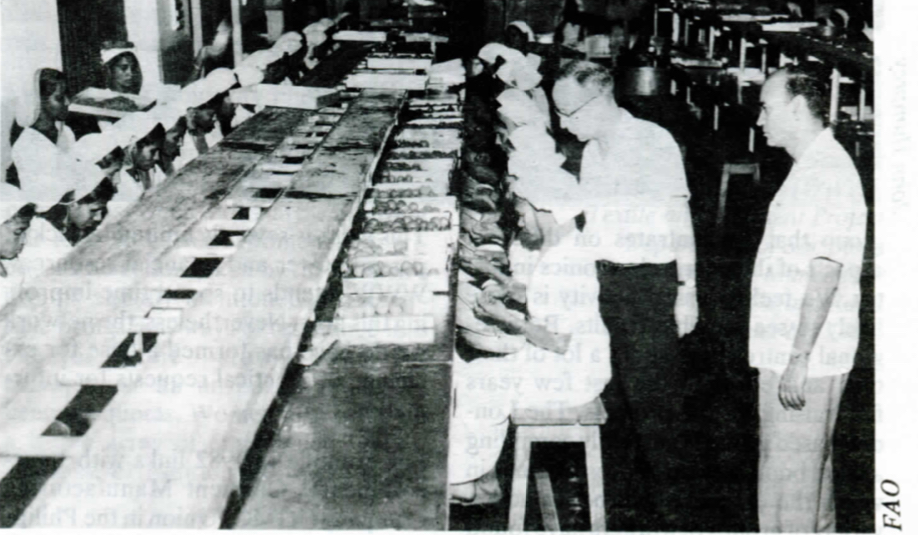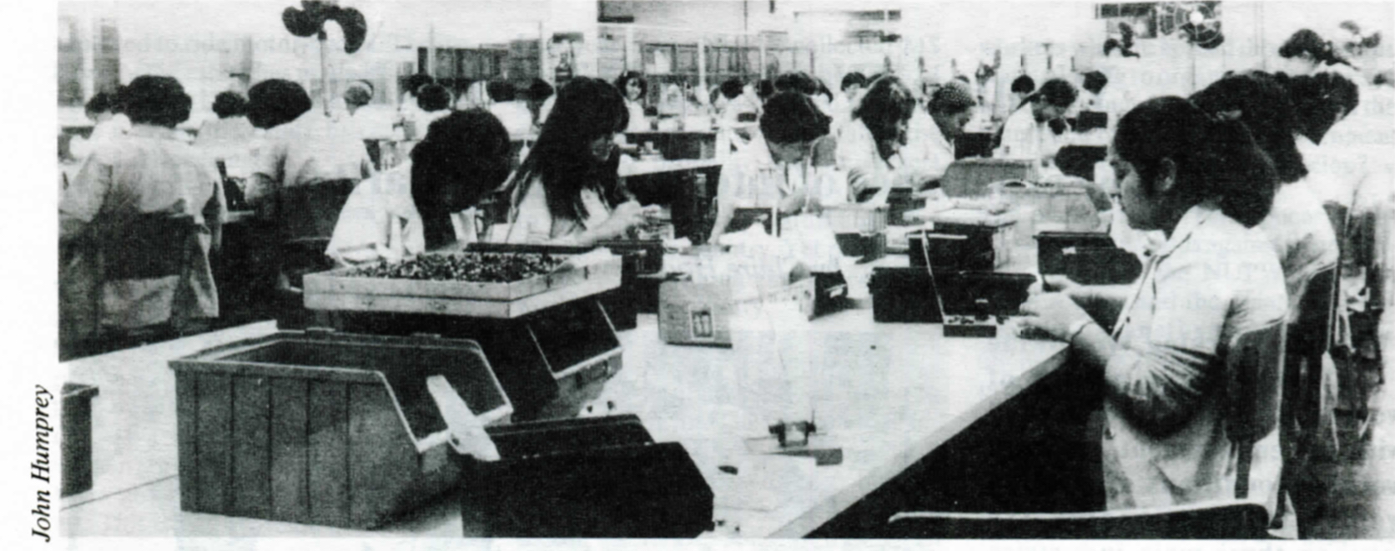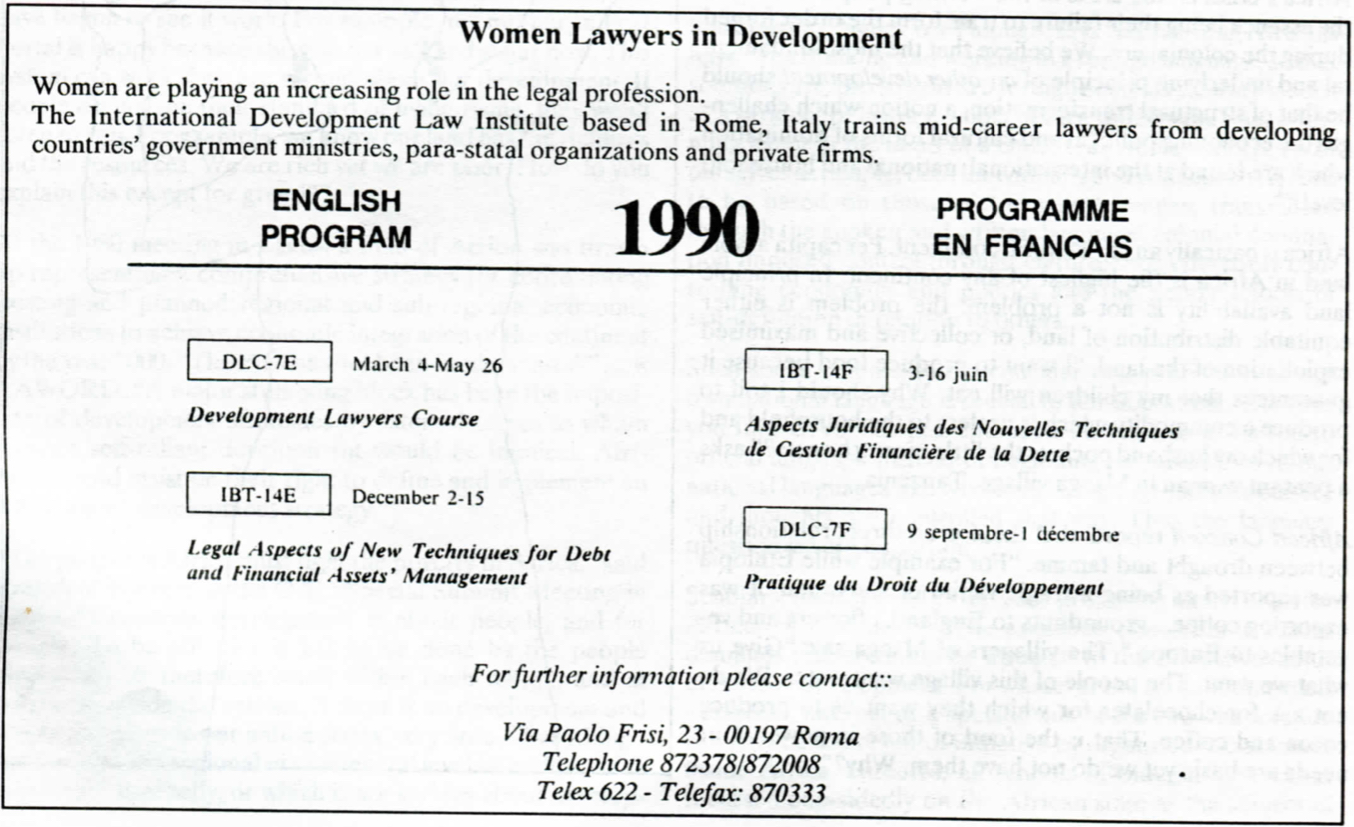Women Working Worldwide:
Our experience of international solidarity
by Claire Hodgson
Women Working Worldwide (WWW) is a group of women in Britain concerned with the employment, pay and working conditions of working women internationally. We focus on three main industries which employ large numbers of women: clothing, textiles and micro-electronics, and on the effects of new technology on women's jobs. Our aim is to support the struggles of women workers through information exchange, international networking and public education. The point of this article is to examine how this can be done, and whether WWW feels it achieves these aims. For those in the small world of international solidarity, 'information exchange, international networking and public education' are familiar terms. But how do they translate into tangible actions?
We feel clear on the political context. That is at least a starting point. As in so many industries in the 1980s, companies controlling clothing, textile and micro-electronics operate across national boundaries. High unemployment and deskilling of women in the UK, growth of employment pportunities in Scotland and Ireland, the closing of a factory in South Korea when women workers begin to make demands, the migration of Sri Lankan women to factories in the Middle East: all these issues can be taken wiihin ihc same context: this context is the aid and foreign policy of western countries, the investment and employment strategies of multinational companies, and the all-pervasive processes of racism and sexism. If women workers are to counter the tactics used to exploit them on a local level they must know the international context. To where is their factory being moved? How much are the new workforce to be paid? What incentives do local elites and government offer the companies?

The organisation is composed of mainly white middle-class, educated women who are not employed in the three industries specified above. The ideal is for organising women to have ready access to innovative means of combatting the forces against them. WWW is not a source of such first-hand experience, but we can facilitate links and information exchange; our position of relative privilege helps us to do so. We accept these limitations and use the resources available to us to further the exchange of other women's experience.
WWW's first activity of this kind was its highly successful conference in 1983 attended by researchers, workers and organisers in the three industries. Out of the conference came the present day WWW. Our first practice of our stated aims was writing and distributing the conference report. To date 2,000 copies have been sold or given free around the world. Since such conferences are attended by few shopfloor workers, distributing the report went some way to making the conference's very real and pertinent conclusions on the state of the industries more accessible to others.
WWW's second major attempt at facilitating the exchange of women's organising experience is through our two current projects. WWW has two regional centres: a Manchester based group that concentrates on the garment and textile industries which employ many local women, and a London group that concentrates on different aspects of the micro-electronics industry. We feel focussed activity is more likely to see tangible results. Both regional centres have spent a lot of their time and effort in the last few years fundraising for the projects. The London based group is currently compiling a hand book of women's testimonies in which the emphasis will be on how a variety of groups of workers have found different ways to resist their exploitation and demand their rights. The Manchester group's project 'The Labour Behind the Label' explores the links between women as producers and as consumers, aiming to build up international contacts and develop educational materials for local use.

WWW's second objective is networking. Over the years we have had built a considerable number of contacts. The starting point was the 1983 conference. Other contacts have been made through attending conferences ourselves and by holding public meetings for visiting women from worker organisations. Our close links with the organisations involved in international development issues have also been a valuable source. The idea is to have an up-to-date list of contacts in all areas of the industries: workers, first world and third, researchers, women's groups, trade unions. However, to maintain contacts, bulletins or updates need to be sent out regularly in order for new groups of women to contact us easily.
This work is severely limited by lack of person power and financial resources. WWW intends lo spend time improving this area. Nevertheless, the network we do have has formed a base for exchange of practical requests for information.
For example in 1982 links with Intercontinental Garment Manufacturing Company (IGMC) Union in the Philippines were established initially through visiting British trade unionists and the Philippine Support Group. Through such groups as WWW and the International Labour Report, the IGMC Union learned that 'Baird' (their international employers), had been saved from the recession in Britain by using cheap female labour in the Philippines. They learned that the garments they made were sold in such high quality shops as Marks and Spencer. Such knowledge is negotiating power for workers when they deal with a local manager threatening to close down the factory. More recent responses to requests for information include sending documents to the women organising against Free Trade Zones in Trinidad and Tobago.
The last stated aim of WWW is 'public education'. The discussions we have had at conferences and workshops have highlighted a clear demand from Third World women to western women for campaigning and educational work in Britain on aid and foreign policies. and the role of multinationals. We have not developed this area of work adequately yet. Funds, as well as time, put a limit on such activities and public education is costly and time consuming. The political climate in Britain means that groups such as ourselves have very little money, no regular income and are dependent almost entirely on voluntary work.
Our activities in this field, however, are not without some success. Both regional offices now have paid workers who have strengthened WWW greatly and provided a positive focus. We now have more time and energy to put into all areas of our work. A large part of the Manchester project will be promoting awareness, producing educational materials for women as workers and consumers, using our links with local industry. Our public meetings with visiting workers and organisers have been" attended by people from the development field from British politics, and from the general public. They have also served to educate us. The following is an example:
In July 1988 Jaya Arunachalam of the Working Women's Forum in India came to Britain to raise funds for her organisation. Jaya spoke of its differing achievements in several regions. Total membership of the Forum reached 85,000 in ten years. Local poor women retained control of each project from the Lacemakers of Narasapur whounionised against a private monopoly, to the migrant Tamil Agarbathi workjers in Bangalore who organised against their exploitative rates of pay. Jaya identified the key to the Forum's national success as its principle of listening to the precise local situation before formulating a plan of action.
We believe international solidarity should follow a similar format: we must emphasise the links between groups of workers whilst gaining strengths from recognising differences. It is all too easy to simplify situations; barriers between women cannot be forgotten. Differences between workers in the same country or continent demonstrate the need for solid regional contacts, networking and information exchange as well as for consolidating international links. If regional differences are great in themselves, then international differences are an even higher hurdle. Western women are, afterall, consumers of the high quality garments made in South East Asian Free Trade Zones.
Despite these problems, the organising of women workers is a clear opportunity to find new ways of resisting the exploitative tactics of international capital. Garments for UK highstreet shops are also made in our own backstreet sweatshops, factories and by im• migrant women homeworkers. Workers in the first world or third, must realise they are fighting the same enemy, the same tactics of divide and rule. Learning from each other is vital.
International solidarity has tended to be the domain of white men in suits, making links only between skilled, unionised labour within particular companies. Such links are important but tend to exclude women's experience. The action taken by the women's groups already mentioned in this article brings new ways of resistance into the forefront - slow downs, for example, or an unspoken refusal to keep up quotas. Women also bring up a whole array of employment issues. They have traditionally worked, and still do work, in the informal sector. Their demands cover such areas as child care, sexual harassment, domestic fuel and food supply. In other words, women's supreme efforts in the organisation of labour open up a whole expense of previously untouched waters. We must take courage from the achievements so far: from the seamstresses union in Mexico City, to the Women's Education and Training Institute in Kandana, Sri Lanka.
Source:
Women Working Worldwide (WWW),
Textile and Garment Project
Department of Sociology
University of Manchester
Oxford Road
Manchester M13 9PL
U.K.


